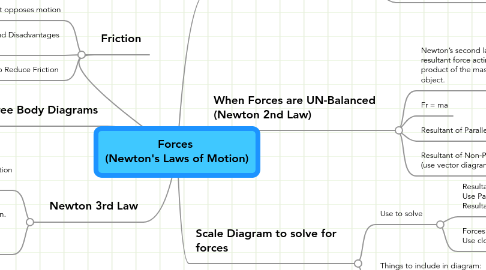Forces (Newton's Laws of Motion)
by Tan Hui Kuan


1. Newton 3rd Law
1.1. Newton’s third law of motion states that for every action there is an equal and opposite reaction If object A exerts a force on object B, then B exerts an equal but opposite force on A
1.2. Newton’s third laws tells us 4 characteristics of forces: 1. Forces always occur in pair. Each pair is made of an action and reaction. 2. Action and reaction forces are equal in magnitude. 3. Action and reaction forces are opposite in direction. 4. Action and reaction forces act on different bodies.
2. Free Body Diagrams
2.1. Simple Diagram to show all the forces acting on a body
2.2. Help to solve problems
3. Friction
3.1. Force that opposes motion
3.2. Advantages and Disadvantages of Frictions
3.3. Ways to Reduce Friction
4. When Forces are balanced (Newton 1st Law)
4.1. an object at rest will remain at rest
4.1.1. E.g: Book Resting on a table
4.2. an object in motion will continue in motion at constant speed in a straight line in the absence of a resultant force acting on it.
4.2.1. Terminal Velocity
4.2.1.1. For Falling Object, when Weight = Air Resistance, No Resultant Force -> No Acceleration -> Falling at a constant velocity (Terminal Velocity)
4.2.1.2. Factors Affecting Terminal Velocity
4.2.1.2.1. Mass The greater the mass, the greater the terminal velocity
4.2.1.2.2. Surface Area The greater the surface area, the smaller the terminal velocity
5. When Forces are UN-Balanced (Newton 2nd Law)
5.1. Newton’s second law of motion states that the resultant force acting upon an object is equal to the product of the mass and the acceleration of the object.
5.2. Fr = ma
5.3. Resultant of Parallel Forces
5.4. Resultant of Non-Parallel Forces (use vector diagram)
6. Scale Diagram to solve for forces
6.1. Use to solve
6.1.1. Resultant Forces Use Parallelogram/Triangle Method Resultant force must have double arrow head
6.1.2. Forces in Equilibrium ( No balanced forces) Use closed triangle method
